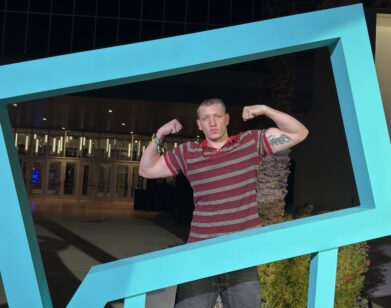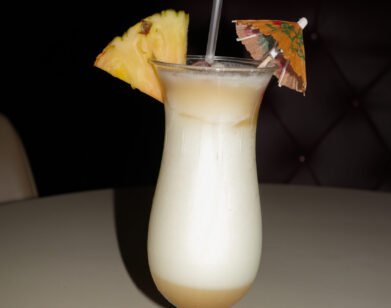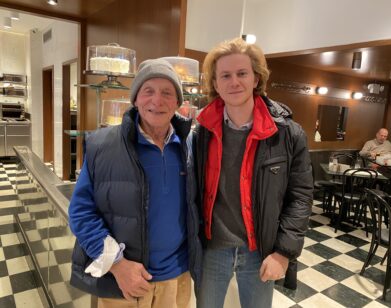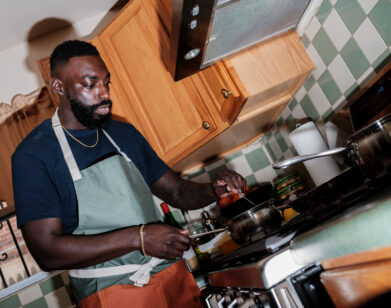COOKED
Mario Carbone Dines Out on Drama
J LEE: Thank you for taking the time. I know you must be insanely slammed right now.
MARIO CARBONE: That’s alright. Happy to do it.
LEE: You guys opened Friday?
CARBONE: Yeah.
LEE: What stuff do you have left to do before the opening?
CARBONE: It’s death by paper cuts right now. So, uh, thousands of little, little details. But, you know, it’s opening a restaurant.
LEE: Yeah. How many is this now?
CARBONE: It’s in the 50s?
LEE: I was just looking through my email, and I applied to work at Torrisi right before you guys were opening in 2009. I have an email from December 2nd to set up an interview.
CARBONE: That’s crazy.
LEE: Yeah, who is this? Nicole? Is that someone—
CARBONE: Yeah, she was the number one employee, really. It was me, Rich, and Nicole. We had one or two other people with us in the kitchen, but there were like five of us.
LEE: That’s crazy. I never showed up for the interview. [Laughs] All the time I’m like, what if I had? I could be part of this empire.
CARBONE: [Laughs] You could have been employee number two.
LEE: No, I mean I was trying to be a barista. Is this your first restaurant in Las Vegas?
CARBONE: It’s our third.
LEE: What’s the vibe?
CARBONE: It starts with its location. It’s on a pretty heritage site as far as Las Vegas goes. It’s in the old Picasso space in the Bellagio here. Right on the water, right on the fountains. It’s a very, very special location, and we wanted to make sure that we made something that was one of one for this space. It’s a fish-forward Carbone restaurant with tons of newness. For those who are very familiar with the Carbone brand, there’s a ton of new food content to the design, the uniforms. It’s definitely a fresh take on the Carbone brand.
LEE: How would you define the Carbone brand?
CARBONE: The Carbone brand is a mid-century fine dining Italian-American restaurant or lifestyle.
LEE: Lifestyle.
CARBONE: Yeah, for sure it’s a lifestyle.
LEE: What would you say is the through line across all of the Major Food Group restaurants?
CARBONE: Theater. Call it experiential, theatrical, thematic, whatever words you want to use. But we are more than just a meal. We’re a night out.
LEE: I remember the first time I went to Carbone. It was my girlfriend’s mom’s 60th birthday, and my girlfriend’s dad was out of town, and the waiter was just like a flirty Italian guy from a movie. He was really turning it on. She was like in love with him. This is the real razzle-dazzle. So yeah, you guys never back away from the drama.
CARBONE: That’s kind of what we do.
LEE: Would you say this is the most dramatic—the Las Vegas location?
CARBONE: Vegas, in and of itself, lends itself to that. It wants that. It is that.
LEE: Yeah. I guess another thing is that your restaurants always have a very American brand of opulence. A lot of your restaurants have a grounding in American cuisine. Is that something that you’re thinking about?
CARBONE: Not necessarily. I try to think about each one and kind of figure out. Who’s its muse? What’s its story? Certainly The Grill is an American story. It’s very much JFK, Mad Men ’60s. Carbone is very much that New York Italian or Italian-American story. But I’d like to think that each brand has its own story, its own muse, its own narrative.
LEE: So, when you’re conceptualizing these spaces, are you coming up with a narrative or a story as the concept?
CARBONE: Yeah, you start with the story. Because you need to tell that story to so many different people, right? From designers, architects, craftsmen that are making certain plates or cutlery for you, and then eventually it starts to trickle down to the staff and the training. Of course, it influences the food. So, for me it always starts with a story.
LEE: Would you say Carbone is Godfather and Riviera is Godfather II? Or is Riviera a sequel? How would you say the narratives work together?
CARBONE: No. Carbone in general is Godfather II, right?
LEE: Yeah, okay, it’s the best one.
CARBONE: It’s born in New York, not Sicily. But, it has obviously very strong ties. I would say this is Godfather goes on vacation. This is Lake Tahoe in Godfather’s reference, but it’s the same period. It’s the same sensibility. It’s the same drama, just applied to a slightly different chapter.
LEE: Had you spent a lot of time in Vegas before opening these restaurants?
CARBONE: I wouldn’t say a lot, but now, the original Carbone that is here is 10 years old. So I’ve spent a great deal of time in Las Vegas over the last decade, for sure.
LEE: Are you a gambler?
CARBONE: I’m not. No.
LEE: Oh, that’s good. Or bad. [Laughs] I’ve never been. What do you think is the best restaurant besides yours in Las Vegas? Where do you like to eat during your time off?
CARBONE: I like Bavette a lot, which is a Chicago steakhouse in Park MGM. There’s a Robuchon at MGM Grand, and that is so special and kind of old school. You know, old cuisine from 15, 20 years ago that is a bit of a time capsule.
LEE: I hear there’s a yacht? What’s up with this yacht?
CARBONE: I wouldn’t classify it as a yacht, but it’s a Riva Aquarama. It’s a very, very special heritage boat. They don’t make them new anymore, but they did make a very, very small amount of them for an anniversary edition. MGM purchased one of them, so it’s an extremely elegant lake boat, really. It really belongs on Lake Como. It fits kind of beautifully and perfectly here, and it’s parked right inside of the restaurant, or outside.
LEE: How many people can it fit?
CARBONE: I would say 4 to 5 to 6 max?
LEE: So it’s a little boat.
CARBONE: Yeah, it’s a little lake boat. But it’s the chicest lake boat you have ever seen.
LEE: That’s amazing. You’re serving food and stuff on there? Champagne?
CARBONE: We’re serving champagne and caviar and light bites and things like that.
LEE: Nice. How often do you go to Italy?
CARBONE: I go to Italy probably two or three times a year.
LEE: What’s your favorite region? Or what regions are you most inspired by?
CARBONE: It would be hard to not be inspired by any of it. I try to go to Milan once a year, I try to go to Rome once a year, and I try to go to the south once a year. And then if there’s any sort of other box that gets checked, that’s a bonus.
LEE: Will Carbone Riviera take any inspiration from the food of the south, like the seafood?
CARBONE: Of course. That’s where the immigrant migration starts, right? You could say that’s the birthplace of Italian-American. So to bring it back full circle is a perfect story.
LEE: I guess this is something I wonder that maybe you know the answer to, but maybe you don’t. If the immigration from Italy—the first wave was Neapolitans and Sicilians—why is it that a lot of the Italian-American cuisine was not seafood forward? Just no access?
CARBONE: Well, meat was very cheap in the U.S., so things like that big Italian-American meatball doesn’t really exist in Italy at all. From my readings and research, it’s all somewhat out of necessity. That’s how they were inexpensively able to feed large families; meat was actually quite cheap. So recipes that came out of it were the chicken parms of the world that don’t exist in proper Italy. That’s the reasoning that I’ve come up with. But, I’ve asked myself that question. Like, why weren’t there more of the Randazzo-type of seafood places? But that’s the best answer I’ve found.
LEE: What are some of the dishes that you’re doing that are inspired more by Neapolitan or Sicilian or European-Italian cuisine at the new spot?
CARBONE: Well, there’s a great deal of it. Certainly most of the pastas. The way we do a linguini with toasted garlic and oregano and tomatoes and Calabrian chili. The way we treat whole fish. Whole fish is a whole new category on this menu, and the different sort of preparations for the different fish and the different sizes. Everything from baked-in herb-salt crust to roasted in wood-burning ovens to grilled over charcoal. These are very simple preparations that are quite difficult when you’re talking about big restaurants and lots of covers. To give the customer a little bit of that moment where they’re like, “I remember when we had this beautiful branzino in southern Italy on that trip.” If I can get that emotion out of them, then I win.
LEE: What are some secrets to assure the consistency and quality? That’s a big question, I guess.
CARBONE: One part of that is a very, very tight training protocol and communication protocol. How the chefs and managers communicate. But also when we’re crafting these menus, we always have an eye toward how is that actually going to get done over the course of a six-hour dinner service, many, many times, over and over again. Is this something that is feasible to do it this way? Because the last thing you want to do is have to reverse-engineer something because it’s not working on the field. So even when we’re making one of something for the first time, I always have in the back of my mind: How would I do this during service?
LEE: Yeah, like a well-oiled machine. Something that you talk about is this captain thing. I feel like that’s an important part that I hear people talk about a lot when they talk about your restaurant. But I think people who haven’t dined with you or people who aren’t so experienced in dining don’t really have a concept of what a captain does? Could you talk about that a bit?
CARBONE: Yeah, it’s an old style of setting up the hierarchy of a dining room. Sort of a very old, formal fine dining thing that I didn’t invent, but we have a certain flavor of style to our service. But a captain, it starts with them getting a huge amount of training. You train them like they’re a chef. They need to know absolutely everything inside and out. They need to know how this thing is prepared, because the beauty in a really seasoned, professional captain is that they’ll end up putting you, the customer, at ease. Then they’re there to guide you. That’s why they’re called captains. They’re there to steer the ship that is your table and take the information that you give them and curate an experience that’s bespoke. And they can only do that if they know absolutely everything about this restaurant, because if they don’t, they have to keep going, “Let me go ask the chef!” Our captains will never come and ask me anything. They know the answers.
LEE: They’re your guide for the evening.
CARBONE: They’re me in the dining room. It’s that important.
LEE: Do you have any tricks for finding your staff? It’s like you got them from Central Casting or something. I’m always like, are they actors? They’re so spot on for whatever story you’re trying to tell.
CARBONE: Staffing is difficult for everybody. I don’t care so much about your resume. I care about your attitude. Are you interested in learning? Do you really want to be here? We have a very, very low turnover rate, which is a huge part of not needing staff all the time. We don’t lose people because we have a great culture in the company, and frankly, we have very busy restaurants, which means really good money. That’s an important part of this. This is a business and this is their business. They need to feed their family with the money they make here. And the customer gets to come in and have this sense of being a regular because they know the people that are in that dining room. They can say hi to four or five people when they walk in. That goes a really long way.
LEE: Do you have a dream concept that’s hard to realize?
CARBONE: We haven’t quite gone out there with our own hotels yet. That’s something that we’re actively working on. I’ve always been a hotel junkie, and I’m excited for Major Food Group to be out there in the hotel universe. So that’s something that is certainly a dream that I hope will be fulfilled in the not-so-distant future.
LEE: Does Carbone differ depending on location?
CARBONE: They’re virtually identical. The menus are the same. When we change a menu in New York, we change them in lockstep across the globe.
LEE: Oh, that’s amazing. Which is your favorite? New York?
CARBONE: I don’t necessarily have a favorite. I always get enamored with the newest one.
LEE: [Laughs] That’s the right answer.
CARBONE: Yeah, I’m just super proud of what the brand’s become.
LEE: But, do you have a dish that you’re most proud of? Something that you think about all the time? Like, “I did this.”
CARBONE: The dish I’m probably most proud of is not in Carbone. It’s at The Grill. We do a dish that is called pasta a la presse.
LEE: Oh, it’s the best dish in New York.
CARBONE: Thank you. If I had to choose one of thousands, that is definitely an outlier.
LEE: Where have you had that dish before? I’ve never had it anywhere else.
CARBONE: I mean, it’s never been done.
LEE: It’s your invention.
CARBONE: Yeah, I made it.
LEE: Wow, I thought it was some historical dish.
CARBONE: That press is a historical item, but it was never used that way. It was a duck press that was used for a very particular duck dish. The way we do it is very unique to us, and we invented pasta a la presse.
LEE: Wow, that’s even more impressive to me. I really thought it was some recipe from the 1920s or something.
CARBONE: No, it has that spirit. We use the tool in a way that it’s intended to be used, just in a way that’s never been done before.
LEE: That’s amazing. Something that I wanted to ask you about is, the new restaurant is in the old Picasso restaurant. Of course The Grill is the Four Seasons restaurant. You must feel an enormous pressure when you’re taking over these historic dining rooms?
CARBONE: I mean it’s privilege, right? I’m really happy that we’re the one that took over The Grill. We were the right team to do that, and to usher it into its new generation, because we cared so much about it. And getting an opportunity to do something like Picasso or inherit a space here in Vegas is just another one of those moments where people trust us to be the custodians of these spaces. Because we do care so much about them and we put so much time and attention into them. That’s doing the space justice.
LEE: Before we go—favorite Italian-American restaurant in New York if you had to choose one? It’s tough, I know.
CARBONE: I grew up going to a place called Parkside in Ozone Park. They’re still there, and that was my Carbone before I had a Carbone.
LEE: What do you get at Parkside?
CARBONE: I haven’t been to Parkside in a really long time, but I remember they had a good eggplant rollatini. The big clams. Don Peppe always said they have the best baked clams in Queens. They might be right, they have good big clams. But Parkside had a hot, mixed antipasti. They probably still do that, and I would always get that. I started going there as a kid, but I probably haven’t been back in 10 years. I’m sure it’s still bumping. People love Italian-American.
LEE: Nice. Well, thank you so much. I really appreciate you taking the time.
CARBONE: My pleasure.
LEE: Good luck with the opening.
CARBONE: Thank you.
LEE: Cheers.







